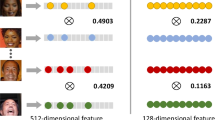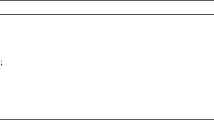Abstract
In the real-world face recognition problems, the collected query set images often suffer serious disturbances. To address the problem, we propose an image set face recognition method based on extended low rank recovery and collaborative representation. By exploiting a Frobenius norm term, an extended low rank representation model is firstly developed to remove all possible disturbances from the query set and reconstruct the rank-one query set. To improve the computational efficiency, a compact and discriminative dictionary is learned from the large gallery set, and the closed form solutions for both the dictionary atom and the coding coefficient are straightway derived. The final classification is performed by using any frame in the reconstructed query set instead of using the whole set, which can further improve the running efficiency. Extensive experiments are conducted on the benchmark Honda/USCD and Youtube Celebrities database to verify that the proposed method outperforms significantly the state-of-the-art methods in terms of robustness and efficiency.





Similar content being viewed by others
References
Kim TK, Kittler J, Cipolla R (2007) Discriminative learning and recognition of image set classes using canonical correlations. IEEE Trans Pattern Anal Mach Intell 29(6):1005–18
Wolf L, Hassner T, Maoz I (2011) Face recognition in unconstrained videos with matched background similarity. In: IEEE conference on computer vision and pattern recognition, pp 529–534
Seo HJ, Milanfar P (2011) Face verification using the lark representation. IEEE Trans Inform Forensics Secur 6(4):1275–1286
Wang R, Shan S, Chen X, Gao W (2008) Manifold-manifold distance with application to face recognition based on image set. In: IEEE conference on computer vision and pattern recognition, pp 1–8
Cevikalp H, Triggs B (2011) Face recognition based on image sets. In: IEEE conference on computer vision and pattern recognition, pp 2567–2573
Hu Y, Mian AS, Owens R (2012) Face recognition using sparse approximated nearest points between image sets. IEEE Trans Pattern Anal Mach Intell 34(10):1992–2004
Wang R, Chen X (2009) Manifold discriminant analysis. In: IEEE conference on computer vision and pattern recognition, pp 429–436
Dai Q, Davis LS, Guo H, Wang R (2012) Covariance discriminative learning: a natural and efficient approach to image set classification. In: IEEE conference on computer vision and pattern recognition, pp 2496–2503
Lee Kuang C, Ho J, Yang MH, Kriegman D (2003) Video-based face recognition using probabilistic appearance manifolds. In: IEEE conference on computer vision and pattern recognition, pp 313–320
Yang M, Zhu P, Van GL, Zhang L (2013) Face recognition based on regularized nearest points between image sets. In: IEEE international conference and workshops on automatic face and gesture recognition, pp 1–7
Zhu P, Zhang L, Zuo W, Zhang D (2013) From point to set: extend the learning of distance metrics. In: IEEE international conference on computer vision, pp 2664–2671
Vishwakarma VP (2015) Illumination normalization using fuzzy filter in dct domain for face recognition. Int J Mach Learn Cybern 6(1):17–34
Yang M, Liu W, Shen L (2015) Joint regularized nearest points for image set based face recognition. In: IEEE international conference and workshops on automatic face and gesture recognition, pp 1–7
Cheng Y, Jin Z, Chen H, Zhang Y, Yin X (2016) A fast and robust face recognition approach combining gabor learned dictionaries and collaborative representation. Int J Mach Learn Cybern 7(1):47–52
Lu J, Wang G, Moulin P (2016) Localized multifeature metric learning for image-set-based face recognition. IEEE Trans Circuits Syst Video Technol 26(3):529–540
Hu H, Gu J (2016) Multi-manifolds discriminative canonical correlation analysis for image set-based face recognition. Cogn Comput 8(5):900–909
Hayat M, Khan SH, Bennamoun M (2017) Empowering simple binary classifiers for image set based face recognition. Int J Comput Vis 123(3):479–498
Lu J, Wang G, Zhou J (2017) Simultaneous feature and dictionary learning for image set based face recognition. IEEE Trans Image Process 26(8):4042–4054
Liu J, Liu W, Ma S, Wang M, Li L, Chen G (2018) Image-set based face recognition using k-svd dictionary learning. Int J Mach Learn Cybern. https://doi.org/10.1007/s13042-017-0782-5
Zhu P, Zuo W, Zhang L, Shiu CK (2014) Image set-based collaborative representation for face recognition. IEEE Trans Inform Forensics Secur 9(7):1120–1132
Candemir S, Borovikov E, Santosh KC, Antani S, Thoma G (2015) Rsilc: rotation-and scale-invariant, line-based color-aware descriptor. Image Vis Comput 42:1–12
Li Y, Liu X, Gao Z (2014) Shadow determination and compensation for face recognition. Int J Mach Learn Cybern 5(4):599–605
Nouyed I, Poon B, Amin MA, Yan H (2016) A study on the discriminating characteristics of gabor phase-face and an improved method for face recognition. Int J Mach Learn Cybern 7(6):1115–1130
Bao S, Song X, Hu G, Yang X, Wang C (2017) Colour face recognition using fuzzy quaternion-based discriminant analysis. Int J Mach Learn Cybern. https://doi.org/10.1007/s13042-017-0722-4
Yang Z, Huang P, Wan M, Zhang F, Yang G, Qian C, Zhang J, Li Z (2018) Local descriptor margin projections (ldmp) for face recognition. Int J Mach Learn Cybern 9(8):1387–1398
Zhu Q, Yuan N, Guan D, Xu N, Li H (2018) An alternative to face image representation and classification. Int J Mach Learn Cybern. https://doi.org/10.1007/s13042-018-0802-0
Peng Y, Ke J, Liu S, Li J, Lei T (2018) An improvement to linear regression classification for face recognition. Int J Mach Learn Cybern. https://doi.org/10.1007/s13042-018-0862-1
Naoufel W, Claudio T, Stefano B (2016) Boosting 3d lbp-based face recognition by fusing shape and texture descriptors on the mesh. IEEE Trans Inform Forensics Secur 11(5):964–979
Claudio T, Naoufel W (2016) Early features fusion over 3d face for face recognition. In: International workshop on representations, analysis and recognition of shape and motion from imaging data, pp 56–64
Bozorgtabar B, Goecke R (2012) An improved nn training scheme using two-stage lda features for face recognition. In: International conference on neural information processing, pp 662–671
Arandjelović O, Shakhnarovich G, Fisher J, Cipolla R, Darrell T (2005) Face recognition with image sets using manifold density divergence. In: IEEE conference on computer vision and pattern recognition, pp 581–588
Vajda S, Santosh KC (2016) A fast k-nearest neighbor classifier using unsupervised clustering. In: International conference on recent trends in image processing and pattern recognition, pp 185–193
Song X, Yang X, Shao C, Yang J (2017) Parity symmetrical collaborative representation-based classification for face recognition. Int J Mach Learn Cybern 8(5):1485–1492
Schroff F, Kalenichenko D, Philbin J (2015) Facenet: A unified embedding for face recognition and clustering. In: IEEE conference on computer vision and pattern recognition, pp 815–823
Hayat M, Khan SH, Werghi N, Goecke R (2017) Joint registration and representation learning for unconstrained face identification. In: IEEE conference on computer vision and pattern recognition, pp 1551–1560
Ramana MOV, Goecke R (2015) Harnessing the deep net object models for enhancing human action recognition. arXiv:1512.06498
Khan SH, He X, Porikli F, Bennamoun M (2017) Forest change detection in incomplete satellite images with deep neural networks. IEEE Trans Geosci Remote Sens 55(9):5407–5423
Taha B, Dias J, Werghi N (2017) Classification of cervical-cancer using pap-smear images: a convolutional neural network approach. In: Conference on medical image understanding and analysis, pp 261–272
Khan SH, Hayat M, Bennamoun M, Sohel FA, Togneri R (2018) Cost-sensitive learning of deep feature representations from imbalanced data. IEEE Trans Neural Netw Learn Syst 29(8):3573–3587
Candes EJ, Li X, Ma Yi, Wright J (2009) Robust principal component analysis. J ACM 58(3):11
Liu G, Lin Z, Shuicheng YJ, Sun YY, Ma Y (2013) Robust recovery of subspace structures by low-rank representation. IEEE Trans Pattern Anal Machine Intell 35(1):171–84
Cambier L, Absil PA (2016) Robust low-rank matrix completion by riemannian optimization. Siam J Sci Comput 38(5):S440–S460
Elhamifar E, Vidal R (2013) Sparse subspace clustering: algorithm, theory, and applications. IEEE Trans Pattern Anal Mach Intell 35(11):2765–2781
Koppen P, Feng Z, Kittler J, Awais M, Christmas W, Xiao JW, Yin HF (2018) Gaussian mixture 3d morphable face model. Pattern Recogn 74:617–628
Zhang L, Yang M, Feng X (2011) Sparse representation or collaborative representation: which helps face recognition. In: International conference on computer vision, pp 471–478
Zhou Z, Li X, Wright J, Candes E (2010) Stable principal component pursuit. In: IEEE international symposium on information theory proceedings, pp 1518–1522
Cai JF, Candes EJ, Shen Z (2008) A singular value thresholding algorithm for matrix completion. Siam J Optimiz 20(4):1956–1982
Chen M, Lin Z, Ma Y, Wu L (2010) The augmented lagrange multiplier method for exact recovery of corrupted low-rank matrices. arXiv:1009.5055
Kim M, Kumar S, Pavlovic V, Rowley H (2008) Face tracking and recognition with visual constraints in real-world videos. In: IEEE conference on computer vision and pattern recognition, pp 1–8
Viola P, Jones MJ (2004) Robust real-time face detection. Int J Comput Vis 57(2):137–154
Acknowledgements
The authors would like to express their sincere gratitude to the anonymous referees, the editor and Ying Li for many valueable suggestions and comments that helped to improve the paper. This work was supported by the National Natural Science Foundation of China (No. 91746107).
Author information
Authors and Affiliations
Corresponding author
Additional information
Publisher's Note
Springer Nature remains neutral with regard to jurisdictional claims in published maps and institutional affiliations.
Rights and permissions
About this article
Cite this article
Song, Z., Cui, K. & Cheng, G. Image set face recognition based on extended low rank recovery and collaborative representation. Int. J. Mach. Learn. & Cyber. 11, 71–80 (2020). https://doi.org/10.1007/s13042-019-00941-6
Received:
Accepted:
Published:
Issue Date:
DOI: https://doi.org/10.1007/s13042-019-00941-6




